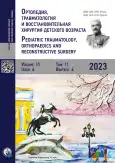Prevention of ankle joint deformities in children on the side of fibular graft intake for microsurgical transposition
- Authors: Ryzhikov D.V.1, Vissarionov S.V.1
-
Affiliations:
- H. Turner National Medical Research Center for Children’s Orthopedics and Trauma Surgery
- Issue: Vol 11, No 4 (2023)
- Pages: 501-506
- Section: Exchange of experience
- Submitted: 21.07.2023
- Accepted: 01.11.2023
- Published: 20.12.2023
- URL: https://journals.eco-vector.com/turner/article/view/562772
- DOI: https://doi.org/10.17816/PTORS562772
- ID: 562772
Cite item
Abstract
BACKGROUND: Reconstructive operations of the musculoskeletal system in children may require the removal of a massive autograft for microsurgical bone grafting. The traditional donor site is the diaphyseal part of the fibula. In the late postoperative period, these patients may develop complications such as a valgus deformity of the ankle joint on the side of the donor fibular defect.
AIM: To analyze the effectiveness of surgical methods for the prevention of hallux valgus of the ankle joint after free transplantation of a fragment of the fibula to replace limb-bone defects in children.
MATERIALS AND METHODS: The treatment results of 11 patients aged 11–16 years (6 girls and 5 boys), in whom an autograft from the fibular diaphysis was used to replace defects in long tubular bones were analyzed. Two patients had a femoral defect as a result of previously transferred hematogenous osteomyelitis. A congenital false joint of the femur was found in 2 patients, bones of the lower leg in 6, and the ulna in 1. The distal fragment of the resected fibula was stabilized by an autograft from the iliac bone, in eight and three cases at the level of the diaphysis and metaphysis of the specified fragment, respectively. The size of the resected fragment in % of the total length of the fibula and the level of distal osteotomy were considered. The presence and magnitude of the proximal displacement of the fragment and the position of the ankle joint gap were evaluated at least 5 years after surgery.
RESULTS: In this study, ≥5 years after the intervention, proximal displacement of the distal fragment of the fibula was absent in only one patient. In the remaining 10, the displacement value did not exceed 3.5 mm. Valgus deformity in the ankle joint of >5° from the initial position developed in two patients. Its progression was prevented by temporary hemiepiphysis of the distal epiphysis of the tibia using a 4.0-mm diameter spongiose screw, whereas in up to 16 months, the valgus deformity progression stopped and decreased to initial values.
CONCLUSIONS: Fibular resection in the optimal variant should preserve the distal part of the bone as much as possible, and the stability of the ankle joint increases with synostosis of the shin bones in the distal diaphyseal section without bringing the bones closer together. When a clinically significant valgus deformity appears (>5° from the initial position) with the preservation of the function of the distal growth zone of the tibia, the use of temporary transphyseal hemiepiphysiodesis of the tibia for correction is optimal.
Full Text
About the authors
Dmitry V. Ryzhikov
H. Turner National Medical Research Center for Children’s Orthopedics and Trauma Surgery
Author for correspondence.
Email: dryjikov@yahoo.com
ORCID iD: 0000-0002-7824-7412
SPIN-code: 7983-4270
MD, PhD, Cand. Sci. (Med.)
Russian Federation, Saint PetersburgSergei V. Vissarionov
H. Turner National Medical Research Center for Children’s Orthopedics and Trauma Surgery
Email: vissarionovs@gmail.com
ORCID iD: 0000-0003-4235-5048
SPIN-code: 7125-4930
MD, PhD, Dr. Sci. (Med.), Professor, Corresponding Member of RAS
Russian Federation, Saint PetersburgReferences
- Fragnière B, Wicart P, Mascard E, et al. Prevention of ankle valgus after vascularized fibular grafts in children. Clin Orthop Relat Res. 2003;(408):245–251. doi: 10.1097/00003086-200303000-00032
- Babhulkar SS, Pande KC, Babhulkar S. Ankle instability after fibular resection. J Bone Joint Surg Br. 1995;77(2):258–261.
- Pacelli LL, Gillard J, McLoughlin SW, et al. A biomechanical analysis of donor-site ankle instability following free fibular graft harvest. J Bone Joint Surg Am. 2003;85(4):597–603. doi: 10.2106/00004623-200304000-00002
- Paley D. Principles of deformity correction. NY: Springer-Verlag; 2005.
- Kanaya K, Wada T, Kura H, et al. Valgus deformity of the ankle following harvesting of a vascularized fibular graft in children. J Reconstr Microsurg. 2002;18(2):91–96. doi: 10.1055/s-2002-19888
- Goh JC, Mech AM, Lee EH, et al. Biomechanical study on the load-bearing characteristics of the fibula and the effects of fibular resection. Clin Orthop Relat Res. 1992;(279):223–228.
- Lang CJ, Frederick RW, Hutton WC. A biomechanical study of the ankle syndesmosis after fibular graft harvest. J Spinal Disord. 1998;11(6):508–513.
- Yang L, Xu HZ, Liang DZ, et al. Biomechanical analysis of the impact of fibular osteotomies at tibiotalar joint: a cadaveric study. Indian J Orthop. 2012;46(5):520–524. doi: 10.4103/0019-5413.101043
- Uchiyama E, Suzuki D, Kura H, et al. Distal fibular length needed for ankle stability. Foot Ankle Int. 2006;27(3):185–189. doi: 10.1177/107110070602700306
- Van der Veen FJ, Strackee SD, Besselaar PP. Progressive valgus deformity of the donor-site ankle after extraperiosteal harvesting the fibular shaft in children. Treatment with osteotomy and synostosis at one session. J Orthop. 2014;12(1):S94–S100. doi: 10.1016/j.jor.2014.03.001
- Agarwal A, Kumar D, Agrawal N, et al. Ankle valgus following non-vascularized fibular grafts in children – an outcome evaluation minimum two years after fibular harvest. Int Orthop. 2017;41(5):949–955. doi: 10.1007/s00264-017-3403-8
- González-Herranz P, del Río A, Burgos J, et al. Valgus deformity after fibular resection in children. J Pediatr Orthop. 2003;23(1):55–59.
- Aurégan JC, Finidori G, Cadilhac C, et al. Children ankle valgus deformity treatment using a transphyseal medial malleolar screw. Orthop Traumatol Surg Res. 2011;97(4):406–409. doi: 10.1016/j.otsr.2011.01.014
Supplementary files










